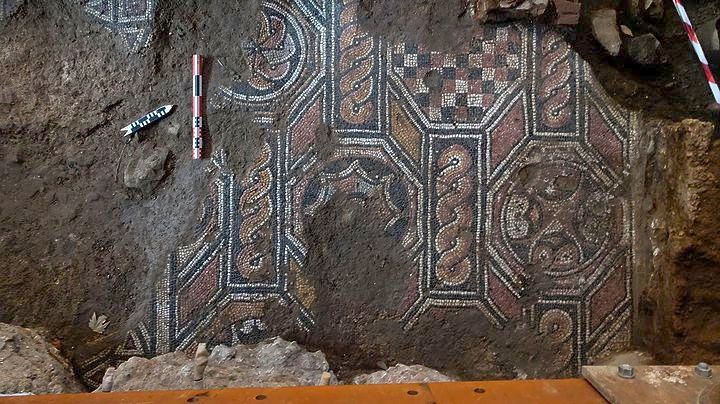The late Roman mosaics found during work for the Thessaloniki metro recently will be extracted, cleaned and be exhibited at the same station they were excavated in, the Central Archaeological Council (CAC) said on Wednesday.
The mosaics were found in the south entrance of the station “Agia Sofia” and are believed to be part of a nearly 315 sq.m. urban villa dated to the first half of the 4th century AD to the 5th century AD, experts said.
Other areas discovered in the villa complex were a section of a pillared corridor (stoa), five consecutive rooms, a complete under-floor wood-heating system (hypocaust), and several multicoloured mosaics, which have been destroyed in parts by subsequent construction layers.
The decoration of the mosaic floors consists of geometric patterns, while one includes a central medallion, possibly depicting Aphrodite, the head of the Thessaloniki Ephorate of Antiquities, Polyxeni Adam-Veleni told the CAC.
She said the head of the figure was missing but the face of Eros, holding on to her, is visible. She added that the villa complex in the multiple-level site is probably “a large urban villa (villa urbana) in the center of town,” as the size of the intact hypocaust at the site corresponds to a house.
Adam-Veleni added, “Thessaloniki had a several such houses, at least 18 have been found until now. In the second half of the 4th century AD, following the founding of Constantinople, a lot of officials settled in the city, where they built huge houses.” The city went through several rebuilding phases in late antiquity, she said, including later on by Byzantine Emperor Justinian, “who paid a lot of attention to Thessaloniki,” she said.
The new findings lay south of the renowned Byzantine highway of “decumanus maximus,” where more mosaics connected to the ones found now were discovered in previous years.
Constantine the Great had initially settled in a palace in Thessaloniki and thought of turning the city into a capital of the Roman Empire before going on to found Constantinople, Adam-Veleni said.
[ANA-MPA]











